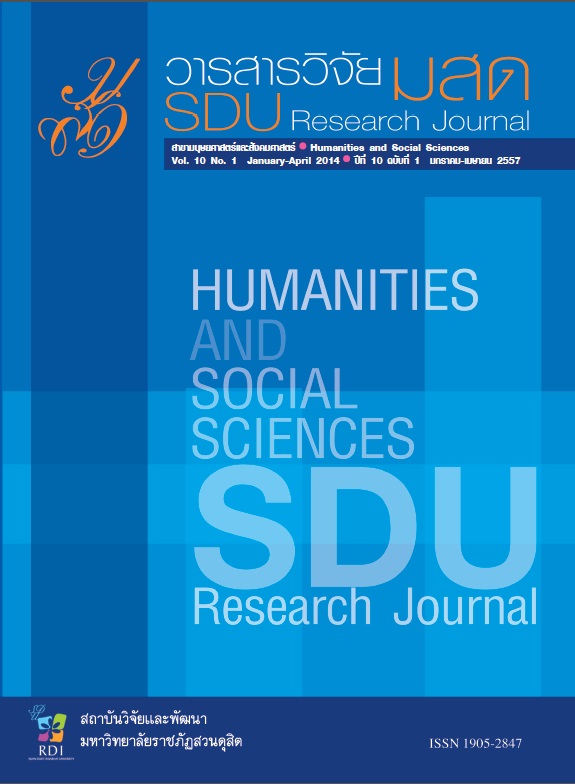การประยุกต์ใช้แนวพระราชดำริเศรษฐกิจพอเพียงกับวิสาหกิจชุมชนในจังหวัดจันทบุรี
Keywords:
เศรษฐกิจพอเพียง, วิสาหกิจชุมชนAbstract
บทคัดย่อ
การวิจัยนี้มีวัตถุประสงค์เพื่อศึกษาระดับความเป็นไปได้ของการประยุกต์แนวพระราชดำริเศรษฐกิจพอเพียงกับวิสาหกิจชุมชนลักษณะต่างๆ และศึกษาเปรียบเทียบระดับความเป็นไปได้ในการประยุกต์ตามแนวพระราชดำริเศรษฐกิจพอเพียงในการดำเนินกิจการวิสาหกิจชุมชน 4 ลักษณะคือ พาณิชยกรรม อุตสาหกรรม เกษตรกรรม และธุรกิจบริการ กับทั้งศึกษาข้อคิดเห็นและแนวทางปฏิบัติที่เหมาะสมในการประยุกต์แนวพระราชดำริเศรษฐกิจพอเพียงกับวิสาหกิจชุมชน โดยเก็บข้อมูลเชิงปริมาณจากผู้ประกอบการวิสาหกิจชุมชนในจังหวัดจันทบุรี จำนวน 388 คน และจัดประชุมกลุ่มเฉพาะผู้ทรงคุณวุฒิ 50 คน เพื่อวิเคราะห์ SWOT เครื่องมือที่ใช้ในการเก็บรวบรวมข้อมูลคือ แบบสัมภาษณ์สำหรับสัมภาษณ์ผู้ประกอบการและแบบบันทึกสำหรับให้ผู้ทรงคุณวุฒิได้แสดงความคิดเห็นรวมทั้งข้อเสนอแนะต่างๆ
ผลการวิจัยมีข้อค้นพบดังนี้ 1) ระดับความเป็นไปได้ในการประยุกต์หลักการจัดการเศรษฐกิจพอเพียงกับวิสาหกิจชุมชนทั้งโดยรวมและจำแนกตามลักษณะของกิจการอยู่ในระดับมากถึงระดับมากที่สุด แนวปฏิบัติที่มีความเป็นไปได้สูงได้แก่ การทำธุรกิจอย่างซื่อสัตย์สุจริตในการประกอบการ ไม่เอารัดเอาเปรียบผู้ที่เกี่ยวข้องส่วนรองลงมาได้แก่ การจัดการธุรกิจที่เน้นการบริหารความเสี่ยงต่ำ ไม่ก่อหนี้เกินกำลัง และจัดการกิจการแบบค่อยเป็นค่อยไป แต่มีความมั่นคงของธุรกิจในระยะยาว และหลักการ ไม่โลภมากจนเกินไป และไม่เน้นกำไรระยะสั้นเป็นหลัก 2) ระดับความเป็นไปได้ในการประยุกต์หลักการจัดการตามแนวพระราชดำริเศรษฐกิจพอเพียงกับวิสาหกิจชุมชน จำแนกตามลักษณะของกิจการ 4 ลักษณะ มีความแตกต่างกันอย่างมีนัยสำคัญทางสถิติที่ระดับความเชื่อมั่นร้อยละ 95 เมื่อทำการเปรียบเทียบความแตกต่างระหว่างค่าเฉลี่ยของลักษณะกิจการต่าง ๆ เป็นรายคู่พบว่ากลุ่มที่ไม่แตกต่างกัน ได้แก่ กลุ่มเกษตรกรรมกับกลุ่มอุตสาหกรรม, กลุ่มพาณิชยกรรมกับกลุ่มธุรกิจบริการ 3) ข้อเสนอแนะที่สำคัญในการประยุกต์แนวพระราชดำริเศรษฐกิจพอเพียงกับวิสาหกิจชุมชน คือ การใช้วัตถุดิบที่มีอยู่ในท้องถิ่น เน้นการจ้างงาน ความประหยัด ซื่อสัตย์ และความสามัคคีปรองดอง ช่วยเหลือเกื้อกูลกัน
คำสำคัญ: เศรษฐกิจพอเพียง, วิสาหกิจชุมชน
ABSTRACT
The purposes of this research were to study the possibility of applying the Royal Sufficiency Economy to various types of community enterprises and compare the level of applicability in four different types of community enterprises: commercial firm, agricultural, industrial, and service business. The research also studied recommendations and appropriate practice guidelines of the application. Quantitative data was collected from 388 entrepreneurs of community enterprises in Chanthaburi province and 50 experts in a focus group discussion for SWOT analysis. The research instrument was comprised of questions for the interviews with the entrepreneurs and forms for experts to note some suggestions.
The findings were as follows:
1) The possibilities of applying the Royal Sufficiency Economy to community enterprises both in overall picture and different types of businesses were at the high and highest levels, respectively. The most possible practice guidelines were honesty in doing business and not taking advantage of others. The second most likely guidelines were low risk management with no debt and gradually proceeding with stability in the long term.
2) The possibility of applying the Royal Sufficiency Economy to community enterprises categorized in four types of businesses was significantly different at a 95 percent confidence level. Concerning paired comparison analysis of the four types of businesses, it was found that the agricultural and industrial businesses as well as the commercial firms and service businesses were not different.
3) The important suggestions regarding the application of the Royal Sufficiency Economy to community enterprises were the use of local raw materials and an emphasis on local employment, savings, honesty, integrity, and sharing.
Keywords: the Royal Sufficiency Economy, community enterprises








